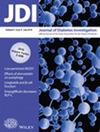Gastric filling ultrasound in assessing gastrointestinal motility in type 2 diabetic patients with neuropathy: A clinical study
Abstract
Aims
This study evaluates gastrointestinal motility dysfunction in type 2 diabetes patients with and without neuropathy compared to healthy individuals using gastric filling ultrasound.
Materials and Methods
We enrolled 210 participants: 50 healthy controls, 106 diabetic controls (without neuropathy), and 54 observation patients (with neuropathy). Gastric emptying times and fullness scores were measured at 30 and 60 min post-meal. Small intestinal transit rates were assessed at baseline and 60 min. Gastric capacity and wall thickness were evaluated by ultrasound, while motilin and glucagon levels were measured by ELISA.
Results
The observation group showed significantly prolonged gastric emptying vs both control groups (30 min: 75.38 ± 13.49 vs 52.46 ± 11.37 vs 45.96 ± 12.85 min; 60 min: 122.53 ± 16.38 vs 84.27 ± 11.44 vs 75.12 ± 10.20 min; all P < 0.001). Gastric fullness scores exhibited similar progressive increases (30 min: 7.45 ± 0.66 vs 5.37 ± 0.75 vs 4.53 ± 0.69; 60 min: 6.84 ± 0.51 vs 4.56 ± 0.68 vs 3.72 ± 0.51; P < 0.001). Small intestinal transit was slowest in the observation group (baseline: 3.62 ± 0.21 vs 4.53 ± 0.36 vs 5.36 ± 0.25 cm/min; 60 min: 3.05 ± 0.15 vs 4.15 ± 0.50 vs 5.25 ± 0.31 cm/min; P < 0.05). The observation group had significantly reduced gastric capacity (714.68 ± 35.49 vs 875.25 ± 53.66 vs 923.63 ± 39.72 mL) and increased wall thickness (4.16 ± 0.55 vs 3.33 ± 0.42 vs 2.98 ± 0.26 cm) vs other groups (P < 0.001). Hormonal changes included lower motilin (28.44 ± 5.16 vs 45.67 ± 7.33 vs 53.71 ± 8.65 pg/mL) and higher glucagon (382.56 ± 23.62 vs 295.14 ± 11.55 vs 256.86 ± 27.90 pg/mL) in the observation group (P < 0.001).
Conclusions
Gastric filling ultrasound demonstrates progressive gastrointestinal impairment from healthy individuals to diabetic patients, with the most severe dysfunction in neuropathic cases. These objective measures support regular gastrointestinal assessment in diabetes management, particularly for patients developing neuropathy.


 求助内容:
求助内容: 应助结果提醒方式:
应助结果提醒方式:


